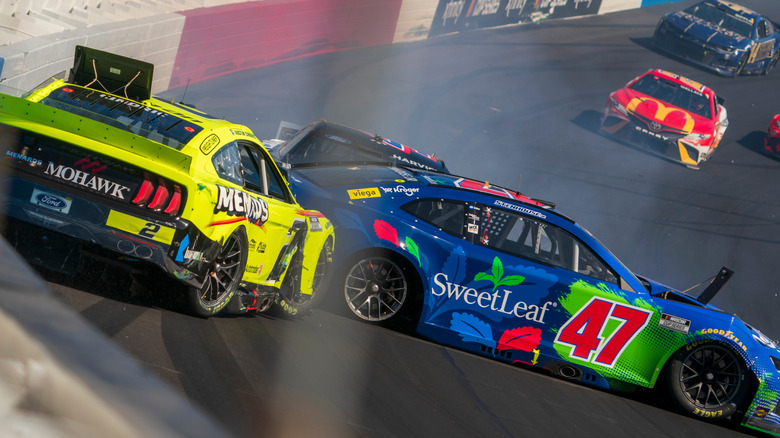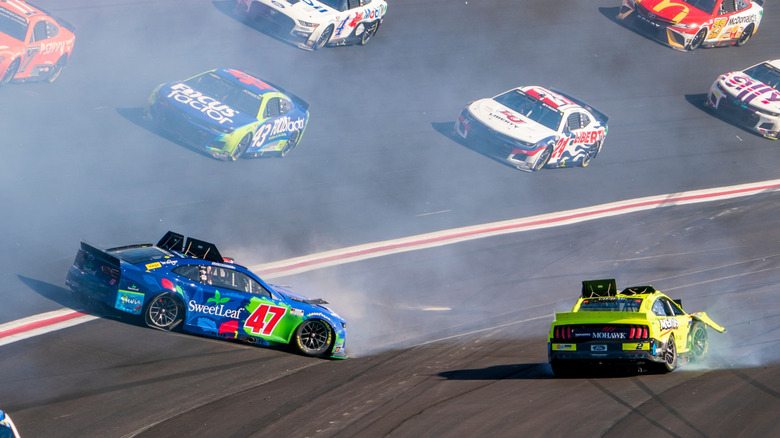Why Do NASCAR Cars Have Roof Flaps? Here's What They're For
There's no denying that NASCAR cars go fast — sometimes too fast. Some of the most shocking moments during the race come when a car lifts off the track, becoming airborne before dangerously hitting the ground. This can occur when the vehicle accidentally leaves the racing asphalt, eliminating the tight grip that the car's tires have on that surface — while reaching almost 200 miles per hour — and coming into contact with grass or even going over small bumps, drastically increasing the risk of going airborne.
It's a bit tricky to keep NASCAR vehicles on the ground when an accident occurs during a race, but there has been a few design implementations over the years meant to reduce the risk. One of those is the roof flap. You have probably seen a piece of the roof lift up while watching videos of gnarly NASCAR crashes — and those are not pieces of the roof falling off. This is actually an important car feature that could save a car from going airborne.
How do roof flaps work in NASCAR?
Roof flaps are meant to come up when a car gets into an accident to avoid it going airborne, changing how air flows around the vehicle in hopes of creating more downforce to keep it grounded. If the car does fly into the air, the flap hopefully brings it back down to the track. NASCAR mandates a certain tether length to ensure the flaps go up at a certain angle that is more likely to accomplish this. The two roof flaps located near the back of the vehicle are also at a certain angle — the right is angled at 45 degrees counter-clockwise.
When a car begins to slide on the track, or off of it, the roof flaps will automatically open. This new component in the air will disrupt the smooth airflow over the car. Breaking this airflow reduces the lift created by the vehicle's high speeds, adding even more downforce and grip on top of the car's front splitter and back spoiler. Rear diffusers underneath the car control how air exits under its body, essentially sucking the car towards the ground due to increased airflow. Stability at high speeds is the name of the game, and the roof flaps are yet another attempt at keeping the car controlled and grounded.
When were roof flaps added to NASCAR cars?
As if car accidents aren't scary enough, NASCAR accidents can sometimes send the car careening through the air. As car speeds increased in the late 1980s, NASCAR started to take note of this phenomenon, especially after Bobby Allison flew into a fence at Talladega. The following year, NASCAR implemented carburetor restrictor plates meant to keep car speeds down, but this didn't stop the flying car problem as effectively as they'd hoped.
By 1994, roof flaps were implemented into NASCAR's vehicle designs as a way to keep cars on the track in an accident. Throughout the years, the roof flap design has changed, like growing larger in 2013, which NASCAR noted as a game changer. "In every crash, I think there can be the element of the unexpected," said then RPM Competition Director Sammy Johns. "I think the tracks and NASCAR and everybody are doing an extremely good job of being proactive nowadays, and not reactive. So as long as we can stay proactive on the safety side, I think we'll continue to have a safe sport."
Another flap was added on the bottom rear of the cars in 2022. These roof flaps have reduced the risk of going airborne by helping push cars back to the track's surface, but the issue is still at large.


